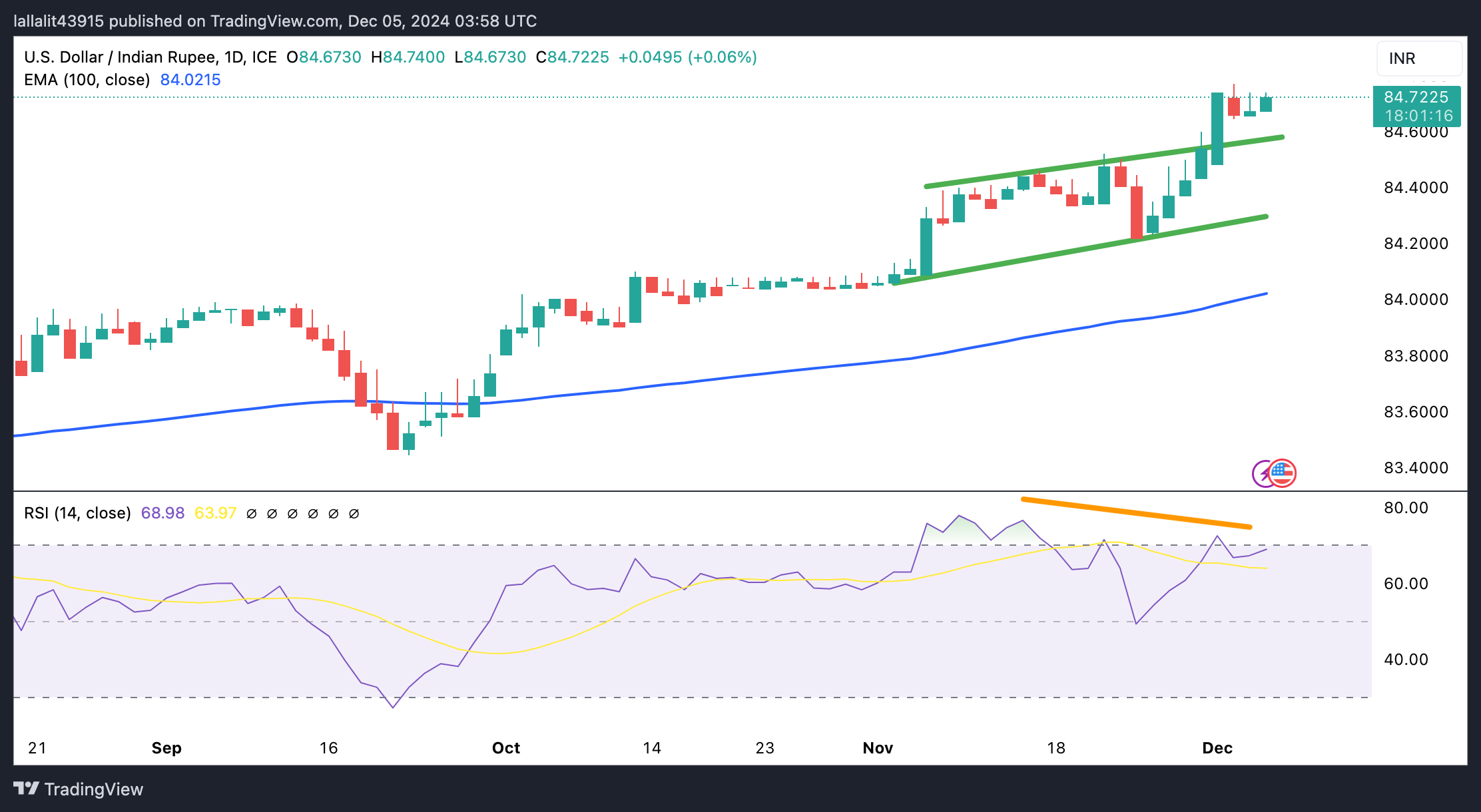- The Indian Rupee extends its decline in the early Asian session on Thursday.
- Disappointing Indian economic data, portfolio outflows and firmer USD undermine INR.
- Investors await releases of US initial jobless claims and goods trade balance later on Thursday.
The Indian Rupee (INR) remains weak near a record low on Thursday despite interventions by the Reserve Bank of India (RBI). Strong demand for the US Dollar (USD), concerns over India’s economic growth and significant outflows from Indian portfolios following Donald Trump’s strength in the US presidential election are putting some selling pressure on the INR.
However, lower crude oil prices could help limit local currency losses as India is the world’s third-largest oil consumer. Investors will closely monitor reports on US initial jobless claims and goods trade balance, due out later on Thursday. On Friday, all eyes will be on the RBI’s interest rate decision and the much-awaited Non-Farm Payrolls (NFP) data.
Indian Rupee weakens amid new record lows
- HSBC India Services PMI came in at 58.4 in November against 59.2 in October. This reading was below the market consensus of 59.5.
- “The rise in hiring reflected improving business confidence in the sector, growth in new orders and robust international demand,” said Pranjul Bhandari, chief India economist at HSBC.
- U.S. service sector growth slowed more than expected in November, falling to 52.1 from 56.0 in October, according to the Institute for Supply Management (ISM) on Wednesday.
- The US S&P Global Composite PMI fell to 54.9 in November, compared to the previous reading and expectation of 55.3. The services PMI fell to 56.1 in November from 57.0 previously, below the consensus of 57.0.
- Fed Chair Jerome Powell noted Wednesday that the U.S. economy is in remarkably good shape, allowing Fed officials to potentially be more cautious in cutting interest rates further. Powell added that unemployment remains very low and that the Fed has made progress on inflation.
Positive picture of USD/INR prevails, but bearish divergence on RSI could limit its upside
The Indian rupee gives ground on the day. The USD/INR pair maintains the bullish trend on the daily time frame, with the pair holding above the 100-day exponential moving average (EMA). However, further consolidation cannot be ruled out as the pair makes higher highs but the 14-day Relative Strength Index (RSI) makes lower highs, indicating a bearish divergence. This suggests that the trend is weakening and the bullish direction could reverse in the short term.
The first resistance level to watch is near the all-time high of 84.77. The extended bullish candles could pave the way towards the psychological mark of 85.00, followed by 85.50.
On the other hand, any additional selling below the support-turned-resistance at 84.60 could expose 84.22, the November 25 low. Potential support level is seen at 84.02, the 100 day EMA.
Indian Rupee FAQs
The Indian Rupee (INR) is one of the currencies most sensitive to external factors. The price of crude oil (the country relies heavily on imported oil), the value of the US Dollar (most trade is done in US dollars), and the level of foreign investment are all influential factors. The Reserve Bank of India’s (RBI) direct intervention in the foreign exchange markets to keep the exchange rate stable as well as the level of interest rates set by the RBI are other important factors influencing the Rupee. .
The Reserve Bank of India (RBI) actively intervenes in foreign exchange markets to maintain a stable exchange rate and help facilitate trade. Furthermore, the RBI tries to keep the inflation rate at its target of 4% by adjusting interest rates. Higher interest rates tend to strengthen the Rupee. This is due to the role of the “carry trade”, in which investors borrow in countries with lower interest rates to park their money in countries that offer relatively higher interest rates and profit from the difference.
Macroeconomic factors that influence the value of the Rupee include inflation, interest rates, economic growth rate (GDP), trade balance and foreign investment inflows. A higher growth rate can lead to more investment abroad, increasing demand for the Rupee. A less negative trade balance will eventually lead to a stronger Rupee. Higher interest rates, especially real rates (interest rates minus inflation) are also positive for the Rupee. A risk environment can lead to higher inflows of foreign direct and indirect investment (FDI and FII), which also benefit the Rupee.
Higher inflation, particularly if it is comparatively higher than other countries, is generally negative for the currency as it reflects a devaluation through excess supply. Inflation also increases the cost of exports, leading to more rupees being sold to buy foreign imports, which is negative for the Indian Rupee. At the same time, higher inflation usually leads the Reserve Bank of India (RBI) to raise interest rates and this can be positive for the Rupee, due to increased demand from international investors. The opposite effect applies to lower inflation.
Source: Fx Street
I am Joshua Winder, a senior-level journalist and editor at World Stock Market. I specialize in covering news related to the stock market and economic trends. With more than 8 years of experience in this field, I have become an expert in financial reporting.






